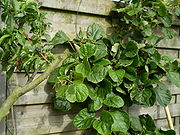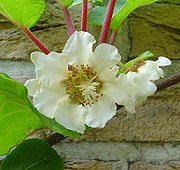
Actinidia deliciosa
Encyclopedia
Actinidia deliciosa or kiwifruit
is native to southern China
, and has been declared the national fruit of that country. Other species of Actinidia
are also found in China and range east to Japan
and north into southeastern Siberia
. This species grows naturally at altitudes between 600 - 2,000 m.
The Black-lyre Leafroller Moth ("Cnephasia" jactatana) is one of the few commercially significant pests of this plant.
 Its leaves are alternate, long-petioled, deciduous, oval to nearly circular, cordate at the base, 7.5-12.5 cm long.
Its leaves are alternate, long-petioled, deciduous, oval to nearly circular, cordate at the base, 7.5-12.5 cm long.
Young leaves are coated with red hairs; mature leaves are dark-green and hairless on the upper surface, downy-white with prominent, light-colored veins beneath.
 The flowers are fragrant, dioecious or bisexual, borne singly or in 3's in the leaf axils, are 5- to 6-petalled, white at first, changing to buff-yellow, 2.5–5 cm broad, and both sexes have central tufts of many stamens though those of the female flowers with no viable pollen. The flowers also lack nectar.
The flowers are fragrant, dioecious or bisexual, borne singly or in 3's in the leaf axils, are 5- to 6-petalled, white at first, changing to buff-yellow, 2.5–5 cm broad, and both sexes have central tufts of many stamens though those of the female flowers with no viable pollen. The flowers also lack nectar.
Male and female flowers appear on different plants (dioecious) and both sexes have to be planted in close proximity for fruit set. Bees are normally used by commercial orchards, although the more labour intensive hand pollination is sometimes employed. Male flowers are gathered and processed to extract their pollen. This is then sprayed back on to the female flowers.
_2_luc_viatour.jpg) The oblong fruits are up to 6.25 cm long. The russet-brown skin of the fruits is densely covered with short, stiff brown hairs.
The oblong fruits are up to 6.25 cm long. The russet-brown skin of the fruits is densely covered with short, stiff brown hairs.
The flesh is firm until fully ripen; it is glistening, juicy and luscious. The color of the flesh is bright-green, or sometimes yellow, brownish or off-white, except for the white, succulent center from which radiate many fine, pale lines.
The flavor is subacid to quite acid; it is suggested that it is similar to the flavors of the gooseberry
or strawberry
.
Zhong Hua (Chinese gooseberry), Jing Li (northern pear gooseberry), Ruan Zao (Soft date gooseberry)and Mao Hua (may be tight- or loose-haired) are 4 main cultivar
s of this species in China. Abbott, Allison, Bruno, Hayward, Monty (Montgomery) and Greensill are the most significant cultivars in New Zealand
.
, London
.
Cultivation spread from China in the early 20th century when seeds were introduced to New Zealand
by Isabel Fraser, the principal of Wanganui Girls' College, who had been visiting mission schools in China. The seeds were planted in 1906 by a Wanganui nurseryman, Alexander Allison, with the vines first fruiting in 1910.
People who tasted the fruit thought it had a gooseberry flavour and began to call it the Chinese Gooseberry, but being from the actinidia family it is not related to the Grossulariaceae (gooseberry
) family.
The familiar cultivar Actinidia deliciosa 'Hayward' was developed by Hayward Wright in Avondale, New Zealand around 1924. This is the most widely grown cultivar in the world. Chinese Gooseberry was initially grown in domestic gardens, but commercial planting began in the 1940s.
In 1959, Turners and Growers named it, Kiwifruit, after New Zealand's national bird, the kiwi
- brown and furry.
Italy is now the leading producer of kiwifruit in the world, followed by New Zealand, Chile, France, Greece, Japan and the United States. Kiwifruit is still produced in its birthplace China, but China has never made it to the top 10 list of kiwifruit producing countries. In China, it is grown mainly in the mountainous area upstream of the Yangtze River. It is also grown in other areas of China, including Sichuan
.
In 2010 and 2011 kiwifruit vines worldwide, in Italy, France and New Zealand, suffered devastating attacks by a bacterial disease caused by Pseudomonas syringae
pv. actinidiae, with some of the New Zealand attacks by the virulent strain PSA-V. The disease had first been noticed in Japan in the 1980s, and subsequently in Northern Italy (1992) and South Korea.
Kiwifruit
The kiwifruit, often shortened to kiwi in many parts of the world, is the edible berry of a cultivar group of the woody vine Actinidia deliciosa and hybrids between this and other species in the genus Actinidia....
is native to southern China
China
Chinese civilization may refer to:* China for more general discussion of the country.* Chinese culture* Greater China, the transnational community of ethnic Chinese.* History of China* Sinosphere, the area historically affected by Chinese culture...
, and has been declared the national fruit of that country. Other species of Actinidia
Actinidia
Actinidia is a genus of woody and, with few exceptions, dioecious plants native to temperate eastern Asia, occurring throughout most of China, Taiwan, Korea and Japan, and extending north to southeast Siberia and south into Indochina...
are also found in China and range east to Japan
Japan
Japan is an island nation in East Asia. Located in the Pacific Ocean, it lies to the east of the Sea of Japan, China, North Korea, South Korea and Russia, stretching from the Sea of Okhotsk in the north to the East China Sea and Taiwan in the south...
and north into southeastern Siberia
Siberia
Siberia is an extensive region constituting almost all of Northern Asia. Comprising the central and eastern portion of the Russian Federation, it was part of the Soviet Union from its beginning, as its predecessor states, the Tsardom of Russia and the Russian Empire, conquered it during the 16th...
. This species grows naturally at altitudes between 600 - 2,000 m.
Description and ecology
Actinidia deliciosa is borne on a vigorous, woody, twining vine or climbing shrub reaching 9 m.The Black-lyre Leafroller Moth ("Cnephasia" jactatana) is one of the few commercially significant pests of this plant.
Leaves

Young leaves are coated with red hairs; mature leaves are dark-green and hairless on the upper surface, downy-white with prominent, light-colored veins beneath.
Flowers

Male and female flowers appear on different plants (dioecious) and both sexes have to be planted in close proximity for fruit set. Bees are normally used by commercial orchards, although the more labour intensive hand pollination is sometimes employed. Male flowers are gathered and processed to extract their pollen. This is then sprayed back on to the female flowers.
Fruits
_2_luc_viatour.jpg)
The flesh is firm until fully ripen; it is glistening, juicy and luscious. The color of the flesh is bright-green, or sometimes yellow, brownish or off-white, except for the white, succulent center from which radiate many fine, pale lines.
The flavor is subacid to quite acid; it is suggested that it is similar to the flavors of the gooseberry
Gooseberry
The gooseberry or ; Ribes uva-crispa, syn. R. grossularia) is a species of Ribes, native to Europe, northwestern Africa and southwestern Asia...
or strawberry
Strawberry
Fragaria is a genus of flowering plants in the rose family, Rosaceae, commonly known as strawberries for their edible fruits. Although it is commonly thought that strawberries get their name from straw being used as a mulch in cultivating the plants, the etymology of the word is uncertain. There...
.
Varieties and cultivars
There are two botanical varieties:- Actinidia deliciosa var. chlorocarpa
- Actinidia deliciosa var. deliciosa
Zhong Hua (Chinese gooseberry), Jing Li (northern pear gooseberry), Ruan Zao (Soft date gooseberry)and Mao Hua (may be tight- or loose-haired) are 4 main cultivar
Cultivar
A cultivar'Cultivar has two meanings as explained under Formal definition. When used in reference to a taxon, the word does not apply to an individual plant but to all those plants sharing the unique characteristics that define the cultivar. is a plant or group of plants selected for desirable...
s of this species in China. Abbott, Allison, Bruno, Hayward, Monty (Montgomery) and Greensill are the most significant cultivars in New Zealand
New Zealand
New Zealand is an island country in the south-western Pacific Ocean comprising two main landmasses and numerous smaller islands. The country is situated some east of Australia across the Tasman Sea, and roughly south of the Pacific island nations of New Caledonia, Fiji, and Tonga...
.
History
In 1847, specimens of the plant were collected by the agent for the Royal Horticultural SocietyRoyal Horticultural Society
The Royal Horticultural Society was founded in 1804 in London, England as the Horticultural Society of London, and gained its present name in a Royal Charter granted in 1861 by Prince Albert...
, London
London
London is the capital city of :England and the :United Kingdom, the largest metropolitan area in the United Kingdom, and the largest urban zone in the European Union by most measures. Located on the River Thames, London has been a major settlement for two millennia, its history going back to its...
.
Cultivation spread from China in the early 20th century when seeds were introduced to New Zealand
New Zealand
New Zealand is an island country in the south-western Pacific Ocean comprising two main landmasses and numerous smaller islands. The country is situated some east of Australia across the Tasman Sea, and roughly south of the Pacific island nations of New Caledonia, Fiji, and Tonga...
by Isabel Fraser, the principal of Wanganui Girls' College, who had been visiting mission schools in China. The seeds were planted in 1906 by a Wanganui nurseryman, Alexander Allison, with the vines first fruiting in 1910.
People who tasted the fruit thought it had a gooseberry flavour and began to call it the Chinese Gooseberry, but being from the actinidia family it is not related to the Grossulariaceae (gooseberry
Gooseberry
The gooseberry or ; Ribes uva-crispa, syn. R. grossularia) is a species of Ribes, native to Europe, northwestern Africa and southwestern Asia...
) family.
The familiar cultivar Actinidia deliciosa 'Hayward' was developed by Hayward Wright in Avondale, New Zealand around 1924. This is the most widely grown cultivar in the world. Chinese Gooseberry was initially grown in domestic gardens, but commercial planting began in the 1940s.
In 1959, Turners and Growers named it, Kiwifruit, after New Zealand's national bird, the kiwi
Kiwi
Kiwi are flightless birds endemic to New Zealand, in the genus Apteryx and family Apterygidae.At around the size of a domestic chicken, kiwi are by far the smallest living ratites and lay the largest egg in relation to their body size of any species of bird in the world...
- brown and furry.
Italy is now the leading producer of kiwifruit in the world, followed by New Zealand, Chile, France, Greece, Japan and the United States. Kiwifruit is still produced in its birthplace China, but China has never made it to the top 10 list of kiwifruit producing countries. In China, it is grown mainly in the mountainous area upstream of the Yangtze River. It is also grown in other areas of China, including Sichuan
Sichuan
' , known formerly in the West by its postal map spellings of Szechwan or Szechuan is a province in Southwest China with its capital in Chengdu...
.
In 2010 and 2011 kiwifruit vines worldwide, in Italy, France and New Zealand, suffered devastating attacks by a bacterial disease caused by Pseudomonas syringae
Pseudomonas syringae
Pseudomonas syringae is a rod shaped, Gram-negative bacterium with polar flagella. It is a plant pathogen which can infect a wide range of plant species, and exists as over 50 different pathovars, all of which are available to legitimate researches via international culture collections such as the...
pv. actinidiae, with some of the New Zealand attacks by the virulent strain PSA-V. The disease had first been noticed in Japan in the 1980s, and subsequently in Northern Italy (1992) and South Korea.

